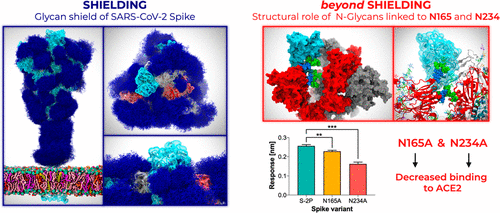当前位置:
X-MOL 学术
›
ACS Cent. Sci.
›
论文详情
Our official English website, www.x-mol.net, welcomes your
feedback! (Note: you will need to create a separate account there.)
Beyond Shielding: The Roles of Glycans in the SARS-CoV-2 Spike Protein
ACS Central Science ( IF 12.7 ) Pub Date : 2020-09-23 , DOI: 10.1021/acscentsci.0c01056 Lorenzo Casalino 1 , Zied Gaieb 1 , Jory A Goldsmith 2 , Christy K Hjorth 2 , Abigail C Dommer 1 , Aoife M Harbison 3 , Carl A Fogarty 3 , Emilia P Barros 1 , Bryn C Taylor 1, 4 , Jason S McLellan 2 , Elisa Fadda 3 , Rommie E Amaro 1, 4
ACS Central Science ( IF 12.7 ) Pub Date : 2020-09-23 , DOI: 10.1021/acscentsci.0c01056 Lorenzo Casalino 1 , Zied Gaieb 1 , Jory A Goldsmith 2 , Christy K Hjorth 2 , Abigail C Dommer 1 , Aoife M Harbison 3 , Carl A Fogarty 3 , Emilia P Barros 1 , Bryn C Taylor 1, 4 , Jason S McLellan 2 , Elisa Fadda 3 , Rommie E Amaro 1, 4
Affiliation

|
The ongoing COVID-19 pandemic caused by severe acute respiratory syndrome coronavirus 2 (SARS-CoV-2) has resulted in more than 28,000,000 infections and 900,000 deaths worldwide to date. Antibody development efforts mainly revolve around the extensively glycosylated SARS-CoV-2 spike (S) protein, which mediates host cell entry by binding to the angiotensin-converting enzyme 2 (ACE2). Similar to many other viral fusion proteins, the SARS-CoV-2 spike utilizes a glycan shield to thwart the host immune response. Here, we built a full-length model of the glycosylated SARS-CoV-2 S protein, both in the open and closed states, augmenting the available structural and biological data. Multiple microsecond-long, all-atom molecular dynamics simulations were used to provide an atomistic perspective on the roles of glycans and on the protein structure and dynamics. We reveal an essential structural role of N-glycans at sites N165 and N234 in modulating the conformational dynamics of the spike’s receptor binding domain (RBD), which is responsible for ACE2 recognition. This finding is corroborated by biolayer interferometry experiments, which show that deletion of these glycans through N165A and N234A mutations significantly reduces binding to ACE2 as a result of the RBD conformational shift toward the “down” state. Additionally, end-to-end accessibility analyses outline a complete overview of the vulnerabilities of the glycan shield of the SARS-CoV-2 S protein, which may be exploited in the therapeutic efforts targeting this molecular machine. Overall, this work presents hitherto unseen functional and structural insights into the SARS-CoV-2 S protein and its glycan coat, providing a strategy to control the conformational plasticity of the RBD that could be harnessed for vaccine development.
中文翻译:

超越屏蔽:聚糖在 SARS-CoV-2 刺突蛋白中的作用
迄今为止,由严重急性呼吸综合征冠状病毒 2 (SARS-CoV-2) 引起的 COVID-19 大流行已导致全球超过 28,000,000 例感染和 900,000 例死亡。抗体开发工作主要围绕广泛糖基化的 SARS-CoV-2 刺突 (S) 蛋白,该蛋白通过与血管紧张素转换酶 2 (ACE2) 结合介导宿主细胞进入。与许多其他病毒融合蛋白类似,SARS-CoV-2 刺突利用聚糖屏蔽来阻止宿主免疫反应。在这里,我们建立了糖基化 SARS-CoV-2 S 蛋白的全长模型,包括开放状态和闭合状态,增强了可用的结构和生物学数据。使用多个微秒长的全原子分子动力学模拟来提供关于聚糖的作用以及蛋白质结构和动力学的原子学视角。我们揭示了N165 和 N234 位点的N-聚糖在调节刺突受体结合域 (RBD) 构象动力学方面的重要结构作用,RBD 负责 ACE2 识别。这一发现得到了生物层干涉测量实验的证实,该实验表明,通过 N165A 和 N234A 突变删除这些聚糖,由于 RBD 构象向“向下”状态转变,显着减少了与 ACE2 的结合。此外,端到端可及性分析概述了 SARS-CoV-2 S 蛋白聚糖屏蔽的脆弱性,可用于针对该分子机器的治疗工作。总体而言,这项工作对 SARS-CoV-2 S 蛋白及其聚糖外壳提出了迄今为止未见的功能和结构见解,提供了一种控制 RBD 构象可塑性的策略,可用于疫苗开发。
更新日期:2020-10-29
中文翻译:

超越屏蔽:聚糖在 SARS-CoV-2 刺突蛋白中的作用
迄今为止,由严重急性呼吸综合征冠状病毒 2 (SARS-CoV-2) 引起的 COVID-19 大流行已导致全球超过 28,000,000 例感染和 900,000 例死亡。抗体开发工作主要围绕广泛糖基化的 SARS-CoV-2 刺突 (S) 蛋白,该蛋白通过与血管紧张素转换酶 2 (ACE2) 结合介导宿主细胞进入。与许多其他病毒融合蛋白类似,SARS-CoV-2 刺突利用聚糖屏蔽来阻止宿主免疫反应。在这里,我们建立了糖基化 SARS-CoV-2 S 蛋白的全长模型,包括开放状态和闭合状态,增强了可用的结构和生物学数据。使用多个微秒长的全原子分子动力学模拟来提供关于聚糖的作用以及蛋白质结构和动力学的原子学视角。我们揭示了N165 和 N234 位点的N-聚糖在调节刺突受体结合域 (RBD) 构象动力学方面的重要结构作用,RBD 负责 ACE2 识别。这一发现得到了生物层干涉测量实验的证实,该实验表明,通过 N165A 和 N234A 突变删除这些聚糖,由于 RBD 构象向“向下”状态转变,显着减少了与 ACE2 的结合。此外,端到端可及性分析概述了 SARS-CoV-2 S 蛋白聚糖屏蔽的脆弱性,可用于针对该分子机器的治疗工作。总体而言,这项工作对 SARS-CoV-2 S 蛋白及其聚糖外壳提出了迄今为止未见的功能和结构见解,提供了一种控制 RBD 构象可塑性的策略,可用于疫苗开发。











































 京公网安备 11010802027423号
京公网安备 11010802027423号